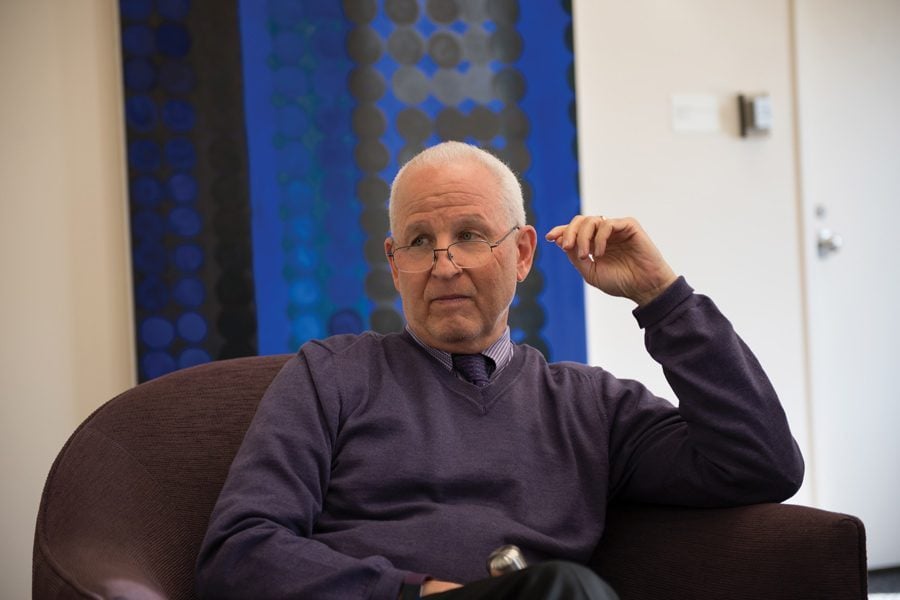Editorial: Despite Schapiro’s advocacy, safe spaces are not guaranteed
Daily file photo by Katie Pach
Northwestern President Morton Schapiro.
May 7, 2019
In January 2016, Northwestern President Morton Schapiro wrote an article in The Washington Post promoting safe spaces, using examples from the Northwestern student community.
“The best hope we have of creating an inclusive community is to first create spaces where members of each group feel safe,” he wrote.
Schapiro’s statements drew a stark contrast to those of officials at other universities, including University of Chicago Dean of Students Jay Ellison, who in 2016 sent a letter to incoming students telling them not to expect safe spaces in their college experience.
Schapiro has continued to advocate for the existence of safe spaces, telling students in his September 2017 convocation address that critics of safe spaces “have no understanding of this generation.” Schapiro’s support of them comes from the goal of empowering students to encounter uncomfortable situations outside of those spaces, because they know they have a comfortable place to return to. “You want them to feel safe and protected so that they voluntarily engage in uncomfortable learning,” he told The Wall Street Journal in 2017.
The president’s strong advocacy of safe spaces has earned him both praise and criticism — it’s no secret that Schapiro believes their benefits. He mentions them annually at convocation, praising them in front of new students and families, thus making Northwestern seem like a more accepting and appealing place.
However, it’s difficult for many students to see how these words translate into direct action. If Schapiro has been advocating for safe spaces so strongly and for so long, why is it still so difficult for marginalized groups to access them on campus?
This summer, the Black House is undergoing renovation. When the house moved through the preliminary design development process through the winter and spring, the University failed to immediately provide a specific replacement space for the house. In April, ASG senators and community members presented a petition in support of a guaranteed replacement space on campus as well as increased autonomy for students in the Black House.
Administrators finally confirmed in May that they will announce the temporary location of the Black House in the coming weeks. But the amount of work that the black community had to undertake to secure a specific space on campus showed a lack of care by the administration. It showed that students had to fight for their safe space — a fight that should have been unnecessary due to Schapiro’s heavy advocacy of safe spaces. He even mentioned black students in his Washington Post article, speaking of students eating together in dining halls and the existence of the Black House.
The Multicultural Greek Council was granted a University-recognized space for the first time — a room on Norris University Center’s ground floor. Lacking the same visibility as the Panhellenic Association and Interfraternity Council due in part to an absence of on-campus houses, MGC members had to fight for proper room and space for its members. Even then, MGC only received a small room in Norris, rather than a larger space to utilize. Additionally, the historically black National Pan-Hellenic Council still does not have a space on campus.
Safe spaces can also extend to living situations. Due to limited gender-open housing options, transgender students have traditionally struggled to find housing options throughout their time living on campus at Northwestern. Historically, the University has designated only single rooms as gender-open housing choices, eliminating the ability for many transgender students — who often cannot change their legal sex on government documentation — to have the often desired experience of living with a roommate.
While Residential Services has committed to expanding gender-open housing, transgender students specifically struggled for extended periods of time attempting to find housing. Living areas should be a space of comfort for all students, and there is no excuse for the struggle it’s been to achieve that.
Student Enrichment Services works out of an office converted from several singles and a lounge in Foster-Walker Complex. SES is one of the few resources on campus for low-income students — and is tasked with the responsibility of serving over 1,100 students. Its unassuming location, hidden in Foster-Walker, makes it difficult to find, limiting its visibility and in turn, the visibility of low-income students.
Additionally, first-generation and low-income students do not have a dedicated space on campus, which some students pushed for through an ASG resolution in February. The SES office is slated to undergo renovations in 2022, only increasing the need to find a separate, new space in the meantime. The FGLI community at Northwestern is often overlooked and minimized by the greater student body, and the lack of a defined, visible safe space or student center increases this marginalization.
These communities are just a few of the marginalized groups that struggle with a lack of safe spaces at NU.
President Schapiro has been open about his affinity for safe spaces both at Northwestern and in national publications. But whether it’s due to slow action from administrators or limited resources, the number of safe spaces is not proportionate to the accessibility President Schapiro touts in his addresses to new students.
If President Schapiro truly believes safe spaces are important to have on campus, he and administrators would make more concrete efforts to increase the validity and the visibility of these spaces. Without these efforts, his advocacy for safe spaces is merely performative.
This piece represents the majority opinion of the Editorial Board of The Daily Northwestern. The views expressed in this piece do not necessarily reflect the views of all staff members or Editorial Board members of The Daily Northwestern.












